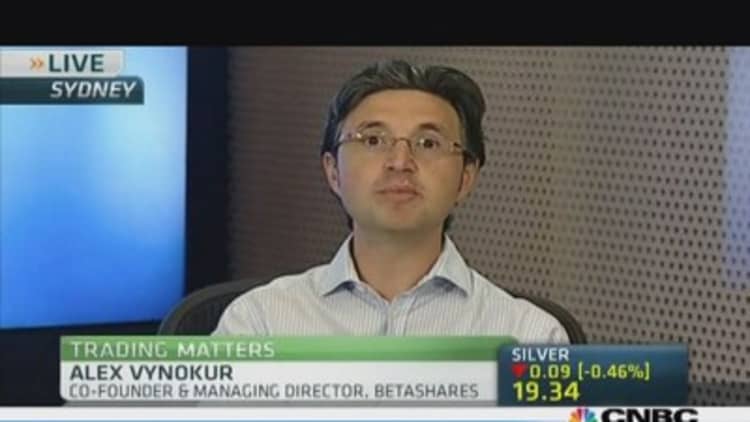The battered Australian dollar traded near multi-year lows against the greenback, euro and British pound on Monday and analysts say the Australian central bank's wish to see the Aussie dollar at $0.85 may soon come true.
In early Asian trade on Monday the Aussie was at $0.8850, pulling closer to its recent three-and-a-half-year low of $0.8820, as signs of improvement in the U.S. economy boosted expectations that the Federal Reserve will continue to taper its asset purchase program.
(Read more: Sit up and take notice, Aussie pain is here to stay)
The currency was also pummeled by the British pound and the euro. On Monday it traded at A$1.5523 per euro, near a four-year low of $1.56 per euro hit last week, and A$1.8620 per pound, a level not seen since 2009, as investors shifted funds away from emerging markets to Europe and the U.S..
"We are looking for further losses in the Australian dollar next year but its sell-off against the greenback should be gradual and limited to 85 cents," said Kathy Lien, managing director at BK Asset Management.
"Bigger moves are expected against the British pound and New Zealand dollar. The recent break of 1.85 in British pound-Australian dollar opens the door for a stronger rally to 1.95-2.0. Aussie-Kiwi is also vulnerable to a move to 1.05," she added, referring to a 3.4 percent move from Monday's levels of 1.0870.
(Read more: No respite in sight for the battered Aussie)
The Aussie has had a tough 2013, losing 15 percent of its value against the dollar year to date, heading for its largest annual loss since 2008.

Slower economic growth, a dovish central bank, combined with expectations of weaker demand from China, Australia's largest trading partner and expectations of U.S. Federal Reserve tapering, have all helped weaken the commodity-linked currency this year.
Recent weakness comes as welcome news to the Reserve Bank of Australia, which has publicly voiced its desire for a weaker currency, in the hope it will boost economic growth. Earlier this month central bank governor Glenn Stevens told The Australian Financial Review that he wanted the currency closer to 85 cents.
Other analysts have also turned increasingly bearish on the currency in recent times. Societe Generale analysts published a note in October saying they expected the currency to fall to $0.72 by 2016, against a backdrop of U.S. tightening, weaker Chinese growth and consequential lower commodity prices.
(Read more: Record profits for Aussie banks, but can it last?)
"We are fairly negative on the Australian dollar, we think it has much further to fall," Todd Elmer, currency strategist at Citi, told CNBC Asia's "Squawk Box" on Monday.
BK Asset Management's Lien, added that although she sees the Aussie falling nearly 4 percent from current levels, she did not see much further downside from 85 cents per dollar.

"There are a significant amount of macro factors that should drive the Australian dollar lower next year, but we do not see a material slide beyond 85 cents," she added.
(Read more: Has the tide turned for corporate Australia?)
Lien explained that the reason the Aussie was set to bottom out at 85 cents was because she saw it regaining its correlation with global equities next year.
She pointed out that the Aussie lost the correlation in 2013, and failed to benefit from the global recovery because it has become too heavily dependent on China. Although she expects Aussie weakness to continue through the first half of the year, she said its fortunes are likely to turnaround in the second half.
"In the second half of the year, we expect the relationship between the Australian dollar and equities to resume when the RBA officially drops its bias to ease," she said.
(Read more: Australia to be'odd one out' in 2014: Goldman Sachs)
"If Fed tapering fails to drive the currency lower and the economy continues to grow below trend due to rising unemployment and weak demand, the RBA could pull the trigger. Yet at most, the central bank only has one more rate cut left in them so even if they cut rates, their bias would shift to neutral limiting the slide in the Australian dollar," she added.
—By CNBC's Katie Holliday: Follow her on Twitter @hollidaykatie


